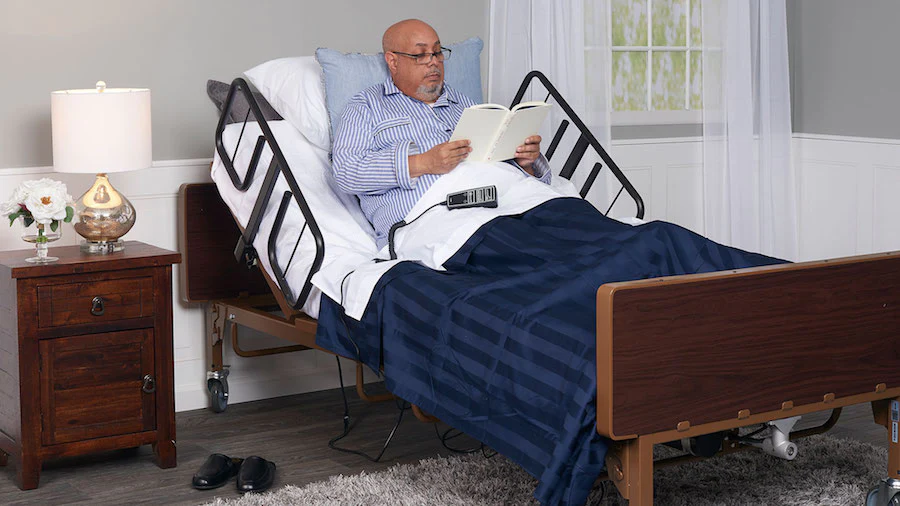


The decision to purchase a home hospital bed, for yourself or a loved one, can feel overwhelming. With so many types of hospital beds for home use available, it can be confusing knowing which home hospital bed is right for you. We’re here to help.
We created a comprehensive overview of different types of hospital beds for home use, positions, and mattresses to help make this difficult change and transition as stress-free as possible.
While all types of hospital beds for home use are adjustable, they are not “one size fits all.” Home hospital beds vary in functions, adjustments, style, size, and more. Below, we break down the most common hospital bed frames:
Manual hospital beds require cranks for bed adjustments which the user or caregiver must physically operate. Manual beds tend to be more cost-effective than semi-electric and full-electric beds but typically lack as many functions, such as height adjustment. These beds tend to be more appropriate for people who require little adjustments to feel comfortable.
| Pros | Cons |
|
|
Semi-electric hospital beds have both electric and manual functions. Usually, the bed base is electronically controlled with a hand pendant and a manual hand crank is used for height adjustments. Semi-electric beds can be a more cost-effective option if you don’t need to adjust the height on a regular basis and only require the bed for a short period of time.
| Pros | Cons |
|
|
Full-electric hospital beds use a remote or pendant to control all bed functions. The head section, knee section, and height functions can be automatically adjusted by pressing the buttons on the pendant without additional assistance. Full-electric beds provide more flexibility and independence for the user.
| Pros | Cons |
|
|
Hi-Low Hospital Beds
Hi-low hospital beds provide extra protection for those at high risk of falling. Hi-low beds offer all the same benefits as a full-electric bed, with a bed deck that can be lowered 7 inches from the ground (without the mattress). Hi-low beds can be automatically raised to protect carers from straining or bending their backs. Hi-low hospital beds make transfers safer and more comfortable for both users and caregivers.
Read our buyer’s guide to Hi-Low Hospitals Beds here
| Pros | Cons |
|
|
Bariatric hospital beds are bigger, stronger full-electric hospital beds with more durability to support patients that weigh 350 lbs to 1,000 lbs. Bariatric hospital beds are generally available in widths of 42”, 48”, 54” and even 60″. These beds offer all the same amenities as the full-electric bed, in a wider, more sturdy frame and adjustable base.
| Pros | Cons |
|
|
As mentioned, the different types of hospital beds for home use are adjustable, with most offering the functionality of head and foot adjustments. Some home hospital beds offer more specific positions to better fit your needs. Some common positions are:
Just as important as the bed frame is the mattress you choose to go with your home hospital bed. A higher grade pressure redistribution mattress increases comfortability and reduces the risk of developing pressure sores. These are a good option for those who spend more time in bed but are still mobile. For those who are restricted to their bed majority of the day, specialty mattresses that include Low Air Loss or Lateral Rotation functions can help prevent, protect, and provide relief from pressure sores. Innerspring mattresses are not recommended for hospital beds because they do not easily move with an adjustable bed. Innerspring mattresses also do not relieve pressure as well and may cause pressure sores.
Read our guide to picking the right mattress for your home hospital bed here
The Lynacare™ HC107 Hi-Low Hospital Bed is our overall favorite home hospital bed. The innovative Lynacare™ HC107 Hi-Low Hospital Bed is designed for all types of home care and long-term care settings and needs. This modern bed provides comfort and safety, for both patients and caregivers, with a hi-low bed frame height, auto contour, dual controls, and a central locking mechanism.
The Lynacare™ HC107 Hi-Low Hospital Bed has numerous positions, including fowler, knee gatch, Trendelenburg, reverse Trendelenburg, dining chair, and cardiac chair, that are easily adjustable with just the touch of a button. The versatile bed deck design has a weight capacity of 500 lbs and can be expanded, without additional tools, from 80″ to 84″ to 88” long and 36″ to 39″ to 42” wide for maximum comfort and safety for all body types.
One of our favorite mattresses, the MedMattress Pro Care Med-Surg Mattress, is created from a dual-layered, multi-density CertiPUR-US® certified foam. This high quality mattress features a firm edge support, 2” cool-gel memory foam, 4” supportive base foam, and a nylon cover. The Pro Care Med-Surg Mattress provides excellent pressure redistribution and postural support, making it ideal for moderate risk patients.
If you’re still having trouble figuring out what bed may be right for you, take our Hospital Bed Quiz! This quick and easy quiz will recommend a hospital bed based on your needs.
Take the quiz here
HomeCare Hospital Beds offers a wide range of affordable, quick ship home hospital beds to fit your needs. When it is time to purchase a home hospital bed for yourself or a loved one, HomeCare Hospital Beds is here to help you. Our team will work with you to help you make an informed purchase that’s right for your needs, budget, and timeline. Call us today 877-414-0002 or email us at info@homecarehospitalbeds.com.
**The information on this site is not intended or implied to be a substitute for professional medical advice. If you are having a severe and sudden change in physical or mental health, please call 911, contact a local emergency facility or consult with your doctor. Always seek the advice of your physician or other qualified healthcare provider, and never disregard the advice given because of information you have received from our website.**




| Cookie | Duration | Description |
|---|---|---|
| cookielawinfo-checkbox-analytics | 11 months | This cookie is set by GDPR Cookie Consent plugin. The cookie is used to store the user consent for the cookies in the category "Analytics". |
| cookielawinfo-checkbox-functional | 11 months | The cookie is set by GDPR cookie consent to record the user consent for the cookies in the category "Functional". |
| cookielawinfo-checkbox-necessary | 11 months | This cookie is set by GDPR Cookie Consent plugin. The cookies is used to store the user consent for the cookies in the category "Necessary". |
| cookielawinfo-checkbox-others | 11 months | This cookie is set by GDPR Cookie Consent plugin. The cookie is used to store the user consent for the cookies in the category "Other. |
| cookielawinfo-checkbox-performance | 11 months | This cookie is set by GDPR Cookie Consent plugin. The cookie is used to store the user consent for the cookies in the category "Performance". |
| viewed_cookie_policy | 11 months | The cookie is set by the GDPR Cookie Consent plugin and is used to store whether or not user has consented to the use of cookies. It does not store any personal data. |